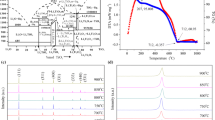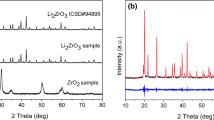Abstract
Practical applications of lithium-ion batteries (LIBs) with both high energy and power density are urgently demanded, which require suitable charge/discharge platform, fast charge-transfer kinetics, as well as optimal solid electrolyte interphase (SEI) layer of electrode materials. In this work, a high-performance lithium-ion battery (LIB) full cell was assembled by using commercial LiNi0.33Co0.33Mn0.33O2 (NCM111) as the positive electrode and mixed Li4Ti5O12 (LTO)/hard carbon (HC) as the negative electrode. It reveals that the component ratio between LTO and HC plays a critical role in manipulating the electric conductivity and the electro-reaction platform. The electrochemical test results show that when the content of HC is 10 wt%, the as-constructed full cell demonstrates the best electrochemical, with a maximum energy density of 149.2 Wh·kg−1 and a maximum power density of 2195 W·kg−1 at 10 A·g−1 (30C). This outperforms all the assembled systems within our work range and the state-of-the-art literatures. The NCM//Li4Ti5O12 + 10 wt% HC battery system also exhibits a good capacity retention after 1000 cycles at the current density of 1 A·g−1. This work provides a new approach to enhance the full-cell performance by mixing electrode materials with different charge potentials and reaction kinetics.
Graphic abstract





Similar content being viewed by others
Change history
24 October 2019
A Correction to this paper has been published: https://doi.org/10.1007/s12598-019-01335-x
References
Huang SF, Li ZP, Wang B, Zhang JJ, Peng ZQ, Qi RJ, Wang J, Zhao YF. N-doping and defective nanographitic domain coupled hard carbon nanoshells for high performance lithium/sodium storage. Adv Funct Mater. 2018;28(10):1796294.
Ge MY, Fang X, Rong JP, Zhou CW. Review of porous silicon preparation and its application for lithium-ion battery anodes. Nanotechnology. 2013;24(42):422001.
Zhang XH, Qiu XY, Kong DB, Zhou L, Li Z, Li XL, Zhi LJ. Silicene flowers: a dual stabilized silicon building block for high-performance lithium battery anodes. ACS Nano. 2017;11(7):7476.
Huang SF, Wang M, Jia P, Wang B, Zhang JJ, Zhao YF. N-graphene motivated SnO2@SnS2 heterostructure quantum dots for high performance lithium/sodium storage. Energy Storage Mater. 2018. https://doi.org/10.1016/j.ensm.2018.11.024.
Zheng HY, Qu QT, Zhu GB, Liu G, Battaglia VS, Zheng HH. Quantitative characterization of the surface evolution for LiNi0.5Co0.2Mn0.3O2/graphite cell during long-term cycling. ACS Appl Mater Interfaces. 2017;9(14):12445.
Jung SK, Gwon H, Hong J, Park KY, Seo DH, Kim H, Hyun J, Yang W, Kang K. Understanding the degradation mechanisms of LiNi0.5Co0.2Mn0.3O2 cathode material in lithium ion batteries. Adv Energy Mater. 2014;4(1):1300787.
Lou W, Gaumet JJ, Mai LQ. Antimonybased intermetallic compounds for lithiumion and sodiumion batteries: synthesis, construction and application. Rare Met. 2017;36(5):321.
Shi SS, Li ZP, Sun Y, Wang B, Liu QN, Hou YL, Huang SF, Huang JZ, Zhao YF. A covalent heterostructure of monodisperse Ni2P immobilized on N, P-co-doped carbon nanosheets for high performance sodium/lithium storage. Nano Energy. 2018;48:510.
Li S, Yang Y, Xie M, Zhang Q. Synthesis and electrochemical performances of high-voltage LiNi0.5Mn1.5O4 cathode materials prepared by hydroxide co-precipitation method. Rare Metals. 2017;36(4):277.
Yun FL, Tang L, Li WC, Jin WR, Pang J, Lu SG. Thermal behavior analysis of a pouch type Li[Ni0.7Co0.15Mn0.15]O2-based lithium-ion battery. Rare Metals. 2016;35(4):309.
Wu J, Lau WM, Geng DS. Recent progress in cobalt-based compounds as high-performance anode materials for lithium ion batteries. Rare Met. 2017;36(5):307.
Liang JJ, Wei ZX, Wang CY, Ma JM. Vacancy-induced sodium-ion storage in N-doped carbon nanofiber@MoS2 nanosheet arrays. Electrochim Acta. 2018;285(20):301.
Liu JD, Liang JJ, Wang CY, Ma JM. Electrospun CoSe@N-doped carbon nanofibers with highly capacitive Li storage. J Energy Chem. 2018. https://doi.org/10.1016/j.jechem.2018.09.006.
Huang J, Wei Z, Liao J, Ni W, Wang C, Ma JM. Molybdenum and tungsten chalcogenides for lithium/sodium-ion batteries: beyond MoS2. J Energy Chem. 2018. https://doi.org/10.1016/j.jechem.2018.09.001.
Zuo WH, Li RZ, Zhou C, Li YY, Xia JL, Liu JP. Battery-supercapacitor hybrid devices: recent progress and future prospects. Adv Sci. 2017;4(7):1600539.
Simon P, Gogotsi Y, Dunn B. Where do batteries end and supercapacitors begin? Science. 2014;343(6176):1210.
Lukatskaya MR, Dunn B, Gogotsi Y. Multidimensional materials and device architectures for future hybrid energy storage. Nat Commun. 2016;7:12647.
Yao F, Pham DT, Lee YH. Carbon-based materials for lithium-ion batteries, electrochemical capacitors, and their hybrid devices. ChemSusChem. 2015;8(14):2284.
Karuppiah S, Franger S, Nallathamby K. Water-soluble green binder for Li4Ti5O12 anodes: effect of binder choice on lithium storage. ChemelEctroChem. 2018;5(2):343.
Gockeln M, Pokhrel S, Meierhofer F, Glenneberg J, Schowalter M, Rosenauer A, Fritsching U, Busse M, Mädler L, Kun R. Fabrication and performance of Li4Ti5O12/C Li-ion battery electrodes using combined double flame spray pyrolysis and pressure-based lamination technique. J Power Sour. 2018;374:97.
Sun LN, Xiong W, Mi HW, Li YL, Zhuo HT, Zhang QL, He CX, Liu JH. In situ coating of graphene-like sheets on Li4Ti5O12 particles for lithium-ion batteries. Electrochim Acta. 2017;230:508.
Ruan D, Huang Y, Li LY, Yuan J, Qiao Z. A Li4Ti5O12 + AC/LiMn2O4 + AC hybrid battery capacitor with good cycle performance. J Alloys Compd. 2017;695:1685.
Hu XB, Deng ZH, Suo J, Pan Z. A high rate, high capacity and long life (LiMn2O4 + AC)/Li4Ti5O12 hybrid battery–supercapacitor. J Power Sour. 2009;936(2):496.
Hu XB, Deng ZH. Study on (LiMn2O4 + AC)/Li4Ti5O12 hybrid battery-capacitor. J Chongqing Univ Technol. 2012;26:21.
Zhao JL, Wang JT, Chang ZH, Lu SG. Performance of Li-rich material with fluoroethylene carbonate as high-voltage electrolyte solvent. Chin J Rare Metals. 2018;42(10):1077.
Kasnatscheew J, Evertz M, Streipert B, Wagner R, Klöpsch R, Vortmann B, Hahn H, Nowak S, Amereller M, Gentschev AC. The truth about the 1st cycle Coulombic efficiency of LiNi1/3Co1/3Mn1/3O2 (NCM) cathodes. Phys Chem Chem Phys PCCP. 2016;18(5):3956.
Mukai K. Pseudo zero-strain insertion materials for Li-ion batteries: cross-sectional observations of LiNi1/2Co1/2O2, LiNi1/3Co1/3Mn1/3O2, and LiNi0.8Co0.15Al0.05O2. Ionics. 2018;24(8):1.
Ghimbeu CM, Górka J, Simone V, Simonin L, Martinet S, Vix-Guterl C. Insights on the Na+ ion storage mechanism in hard carbon: discrimination between the porosity, surface functional groups and defects. Nano Energy. 2017;44:327.
Li ZF, Bommier C, Chong ZS, Jian ZJ, Surta TW, Wang XF, Xing ZY, Neuefeind JC, Stickle WF, Dolgos M. Mechanism of Na-ion storage in hard carbon anodes revealed by heteroatom doping. Adv Energy Mater. 2017;7(18):1602894.
Gaddam RR, Yang DF, Narayan R, Raju K, Kumar NA, Zhao XS. Biomass derived carbon nanoparticle as anodes for high performance sodium and lithium ion batteries. Nano Energy. 2016;26:346.
Hu XB, Deng ZH, Suo J, Pan Z. A high rate, high capacity and long life (LiMn2O4 + AC)/Li4Ti5O12 hybrid battery–supercapacitor. J Power Sour. 2009;187(2):635.
Ping LN, Zheng JM, Shi ZQ, Jie QI, Wang CY. Electrochemical performance of MCMB/(AC + LiFePO4) lithium-ion capacitors. Sci Bull. 2013;58(6):689.
Sun XZ, Zhang X, Huang B, Zhang HT, Zhang DC, Ma YW. (LiNi0.5Co0.2Mn0.3O2 + AC)/graphite hybrid energy storage device with high specific energy and high rate capability. J Power Sour. 2013;243(6):361.
Acknowledgements
This work was financially supported by the National Natural Science Foundation of China (No. 51774251), Hebei Natural Science Foundation for Distinguished Young Scholars (No. B2015203096), the Hundred Excellent Innovative Talents Support Program in Hebei Province (No. SLRC2017057), the Scientific Research Foundation for the Returned Overseas Chinese Scholars (No. CG2014003002) and the Open Funding from State Key Laboratory of Advanced Chemical Power Sources (No. SKL-ACPS-C-11).
Author information
Authors and Affiliations
Corresponding author
Electronic supplementary material
Below is the link to the electronic supplementary material.
Rights and permissions
About this article
Cite this article
Huang, SF., Lv, Y., Tie, D. et al. Realizing simultaneously enhanced energy and power density full-cell construction using mixed hard carbon/Li4Ti5O12 electrode. Rare Met. 40, 65–71 (2021). https://doi.org/10.1007/s12598-019-01312-4
Received:
Revised:
Accepted:
Published:
Issue Date:
DOI: https://doi.org/10.1007/s12598-019-01312-4




